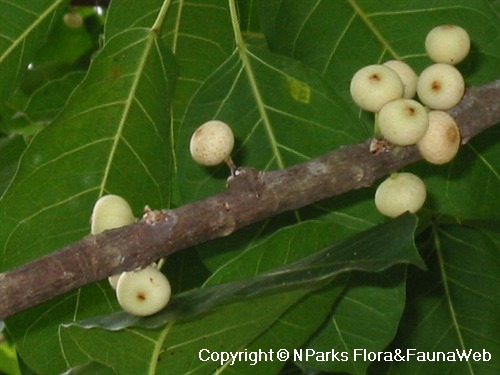
Name
Classifications and Characteristics
| Plant Division | Angiosperms (Flowering Seed Plants) (Dicotyledon) |
|---|---|
| Plant Growth Form | Tree (Medium (16m-30m)) |
| Lifespan (in Singapore) | Perennial |
| Mode of Nutrition | Autotrophic |
| Plant Shape | Umbrella, Broad / Mushroom / Hemispherical |
| Maximum Height | 30 m |
Biogeography
| Native Distribution | Thailand, Cambodia, Peninsular Malaysia, Singapore, Indonesia, Timor-Leste |
|---|---|
| Native Habitat | Terrestrial (Monsoon Forest, Coastal Forest), Shoreline (Coastal Cliff, Backshore, Sandy Beach, Rocky Beach) |
| Preferred Climate Zone | Tropical, Sub-Tropical / Monsoonal |
| Local Conservation Status | Native to Singapore (Endangered (EN)) |
Description and Ethnobotany
| Growth Form | It is a magnificent tree up to 30 m tall, with an umbrella-shaped crown. Its stout twigs are densely covered with fine, silky, white or whitish buds. It is a deciduous tree, shedding its leaves regularly. During leaf fall, its crown, branches and trunk are bare. During new leaf growth, its crown is covered with young leaves that are pink, turning fresh green, then darker green. The cycle repeats itself every few months when leaf fall occurs. |
|---|---|
| Crown | Umbrella-shaped, broad and spreading. |
| Foliage | Its alternate, long-stalked leaves have thinly leathery leaf blades that are usually oval with rounded or slightly heart-shaped bases, slightly undulating, dark green, and 7.5–26 by 3–14 cm. |
| Flowers | The plant is monoecious. Its male, female and gall flowers are found within the same syconium (fig). The flowers are tiny and develop within the syconium (fig). |
| Fruit | Its stalked syconia (figs) are pear-shaped, 10–19 mm wide, turning white to pale yellow to pink then purple when ripe, and occur in clusters of up to 5 on the bare portions of twigs and branches. Each syconium contains many seeds. |
| Habitat | It grows in coastal and monsoon forests, on rocky and sandy beaches, at low altitudes. It occurs locally in Pulau Ubin. |
| Associated Fauna | Its flowers are pollinated by the fig wasp (Blastophaga ishiiana) and its ripe syconia (figs) are eaten by birds. Asian Glossy Starling, Daurian Starling, Pink-necked Green Pigeon, Pied Imperial Pigeon, Jambu Fruit Dove, Yellow-vented Bulbul, Olive-winged Bulbul, Black-naped Oriole, Coppersmith Barbet, Asian Koel, Straw-headed Bulbul are observed to be feeding on the fig. |
| Cultivation | It can be propagated by seed, stem cutting, or air-layering. |
| Etymology | Latin Ficus, the commercial edible fig (Ficus carica); Latin superba, superb, referring to the plant’s foliage |
| Ethnobotanical Uses | Cultural / Religious: Heritage Tree: There are 8 individuals of Ficus superba listed as Heritage Trees in Singapore. They are found at St. John's Island, the eastern part of Singapore and at Nanyang Technological University. To find out more about these trees, please visit the Heritage Tree Register. |
Landscaping Features
| Landscaping | Its seasonally changing foliage makes it an attractive plant for gardens, parks, and roadsides. |
|---|---|
| Desirable Plant Features | Ornamental Foliage |
| Landscape Uses | General, Suitable for Roadsides, Parks & Gardens, Coastal, Beachfront / Shoreline |
Fauna, Pollination and Dispersal
| Fauna Pollination Dispersal Associated Fauna | Bird-Attracting, Caterpillar Moth Food Plant, Bat Food |
|---|---|
| Pollination Method(s) | Biotic (Fauna) |
| Seed or Spore Dispersal | Biotic (Fauna) |
Plant Care and Propagation
| Light Preference | Full Sun |
|---|---|
| Water Preference | Moderate Water |
| Plant Growth Rate | Moderate |
| Rootzone Tolerance | Well-Drained Soils, Saline Soils / Salt Spray |
| Propagation Method | Seed, Stem Cutting |
Foliar
| Foliage Retention | Deciduous |
|---|---|
| Mature Foliage Colour(s) | Green |
| Mature Foliage Texture(s) | Leathery, Thin |
| Prominent Young Flush Colour(s) | Orange, Red |
| Young Flush Texture(s) | Leathery |
| Foliar Type | Simple / Unifoliate |
| Foliar Arrangement Along Stem | Alternate |
| Foliar Attachment to Stem | Petiolate |
| Foliar Shape(s) | Non-Palm Foliage (Ovate) |
| Foliar Venation | Pinnate / Net |
| Foliar Margin | Entire, Entire - Wavy / Undulate |
| Foliar Apex - Tip | Acute |
| Foliar Base | Cordate |
| Leaf Area Index (LAI) for Green Plot Ratio | 3.0 (Tree - Intermediate Canopy) |
Non - Foliar and Storage
| Trunk Type (Non Palm) | Woody |
|---|---|
| Root Type | Underground, Aboveground (Strangling Root) |
Floral (Angiosperm)
| Flower & Plant Sexuality | Unisexual Flowers , Monoecious |
| Flower Grouping | Cluster / Inflorescence |
|---|
| Flower Location | Cauliflorous |
| Inflorescence Type | Syconium |
Fruit, Seed and Spore
| Mature Fruit Colour(s) | White, Purple, Pink, Cream / Off-White |
|---|---|
| Fruit Classification | Multiple Fruit |
| Fruit Type | Fleshy Fruit , Accessory / False Fruit (Pseudocarp) |
Image Repository
Others
| Master ID | 1623 |
|---|---|
| Species ID | 2916 |
| Flora Disclaimer | The information in this website has been compiled from reliable sources, such as reference works on medicinal plants. It is not a substitute for medical advice or treatment and NParks does not purport to provide any medical advice. Readers should always consult his/her physician before using or consuming a plant for medicinal purposes. |

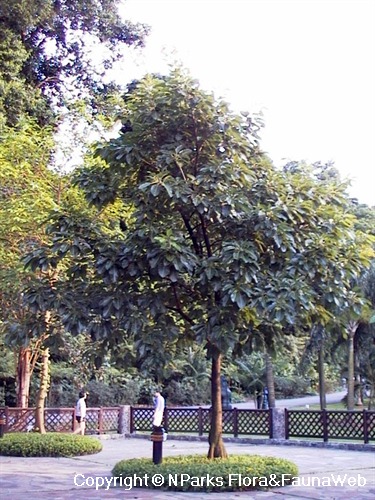
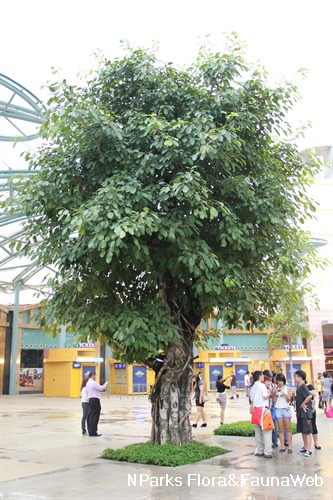
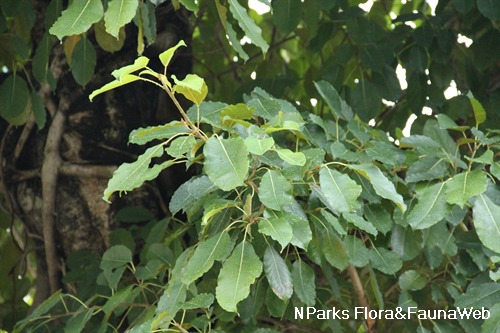
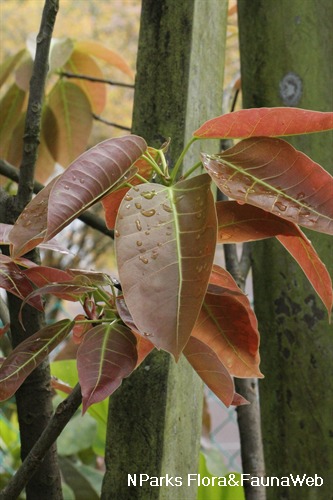
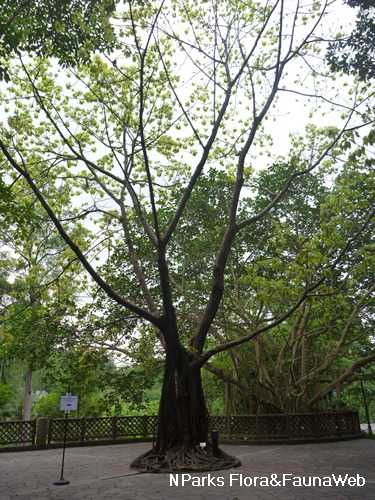
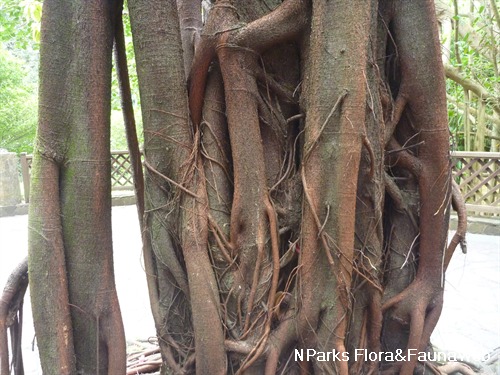
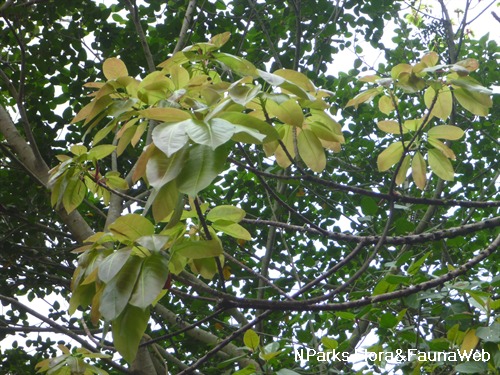
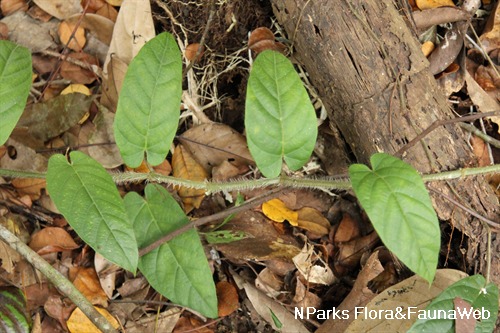
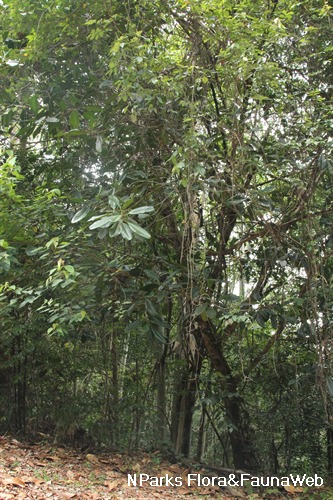

.jpg)